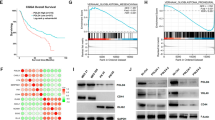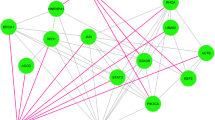Abstract
Objective
To elucidate the molecular mechanism of microRNA-215 (miR-215) in the migration and invasion of high grade glioma.
Results
42 Patients were analysed for clinicopathological characteristics. qRT-PCR showed that miR-215 was up-regulated in glioma tissues compared with non-neoplastic brain tissues (P < 0.05). The up-regulated miR-215 was closely associated with high grade glioma (P < 0.01) and poor overall survival (P < 0.01). Transwell assay showed that re-expression of miR-215 enhanced migration and invasion of glioma cells. miR-215 also down-regulated retinoblastoma tumor suppressor gene 1 (RB1) expression by targeting its 3′-UTR. Reversely, re-expression of RB1 inhibited partial effect of miR-215 on migration and invasion in vitro.
Conclusions
Re-expression of miR-215 promoted cell migration and invasion of glioma by targeting RB1. miR-215 can thus be used as a biomarker for tumor progression and prognosis in human high grade glioma.




Similar content being viewed by others
Change history
23 July 2022
This article has been retracted. Please see the Retraction Notice for more detail: https://doi.org/10.1007/s10529-022-03283-6
References
Cito L, Pentimalli F, Forte I, Mattioli E, Giordano A (2010) Rb family proteins in gastric cancer (review). Oncol Rep 24:1411–1418
Cuddapah VA, Robel S, Watkins S, Sontheimer H (2014) A neurocentric perspective on glioma invasion. Nat Rev Neurosci 15:455–465
Deng Y, Huang Z, Xu Y, Jin J et al (2014) MiR-215 modulates gastric cancer cell proliferation by targeting RB1. Cancer Lett 342:27–35
Deshpande A, Hinds PW (2006) The retinoblastoma protein in osteoblast differentiation and osteosarcoma. Curr Mol Med 6:809–817
Doorbar J (2006) Molecular biology of human papillomavirus infection and cervical cancer. Clin Sci (Lond) 110:525–541
Duan R, Han L, Wang Q, Wei J, Chen L, Zhang J, Kang C, Wang L (2015) HOXA13 is a potential GBM diagnostic marker and promotes glioma invasion by activating the Wnt and TGF-beta pathways. Oncotarget 6:27778–27793
Gabriely G, Wurdinger T, Kesari S, Esau CC, Burchard J, Linsley PS, Krichevsky AM (2008) MicroRNA 21 promotes glioma invasion by targeting matrix metalloproteinase regulators. Mol Cell Biol 28:5369–5380
Georges SA, Biery MC, Kim SY, Schelter JM et al (2008) Coordinated regulation of cell cycle transcripts by p53-Inducible microRNAs, miR-192 and miR-215. Cancer Res 68:10105–10112
Goodrich DW, Wang NP, Qian YW, Lee EY, Lee WH (1991) The retinoblastoma gene product regulates progression through the G1 phase of the cell cycle. Cell 67:293–302
Hu W, Feng Z, Teresky AK, Levine AJ (2007) p53 regulates maternal reproduction through LIF. Nature 450:721–724
Hu G, Drescher KM, Chen XM (2012) Exosomal miRNAs: biological properties and therapeutic potential. Front Genet 3:56
Hu J, Sun T, Wang H, Chen Z et al (2016) MiR-215 is induced post-transcriptionally via HIF-drosha complex and mediates glioma-initiating cell adaptation to hypoxia by targeting KDM1B. Cancer Cell 29:49–60
Karaayvaz M, Pal T, Song B, Zhang C, Georgakopoulos P, Mehmood S, Burke S, Shroyer K, Ju J (2011) Prognostic significance of miR-215 in colon cancer. Clin Colorectal Cancer 10:340–347
Kozomara A, Griffiths-Jones S (2011) miRBase: integrating microRNA annotation and deep-sequencing data. Nucleic Acids Res 39:D152–D157
Le AP, Huang Y, Pingle SC, Kesari S, Wang H, Yong RL, Zou H, Friedel RH (2015) Plexin-B2 promotes invasive growth of malignant glioma. Oncotarget 6:7293–7304
Li S, Gao J, Gu J, Yuan J, Hua D, Shen L (2013) MicroRNA-215 inhibits relapse of colorectal cancer patients following radical surgery. Med Oncol 30:549
Li N, Zhang QY, Zou JL, Li ZW et al (2016) miR-215 promotes malignant progression of gastric cancer by targeting RUNX1. Oncotarget 7:4817–4828
Munakata T, Liang Y, Kim S, McGivern DR, Huibregtse J, Nomoto A, Lemon SM (2007) Hepatitis C virus induces E6AP-dependent degradation of the retinoblastoma protein. PLoS Pathog 3:1335–1347
Munger K, Howley PM (2002) Human papillomavirus immortalization and transformation functions. Virus Res 89:213–228
Pichiorri F, Suh SS, Rocci A, De Luca L et al (2010) Downregulation of p53-inducible microRNAs 192, 194, and 215 impairs the p53/MDM2 autoregulatory loop in multiple myeloma development. Cancer Cell 18:367–381
Senanayake U, Das S, Vesely P, Alzoughbi W, Frohlich LF, Chowdhury P, Leuschner I, Hoefler G, Guertl B (2012) miR-192, miR-194, miR-215, miR-200c and miR-141 are downregulated and their common target ACVR2B is strongly expressed in renal childhood neoplasms. Carcinogenesis 33:1014–1021
Stupp R, Mason WP, van den Bent MJ, Weller M et al (2005) Radiotherapy plus concomitant and adjuvant temozolomide for glioblastoma. N Engl J Med 352:987–996
Tong YQ, Liu B, Zheng HY, Gu J et al (2015) MiR-215, an activator of the CTNNBIP1/beta-catenin pathway, is a marker of poor prognosis in human glioma. Oncotarget 6:25024–25033
Tu Y, Gao X, Li G, Fu H, Cui D, Liu H, Jin W, Zhang Y (2013) MicroRNA-218 inhibits glioma invasion, migration, proliferation, and cancer stem-like cell self-renewal by targeting the polycomb group gene Bmi1. Cancer Res 73:6046–6055
Wijnhoven BP, Hussey DJ, Watson DI, Tsykin A, Smith CM, Michael MZ, South Australian Oesophageal Research G (2010) MicroRNA profiling of Barrett’s oesophagus and oesophageal adenocarcinoma. Br J Surg 97:853–861
Wu CL, Zukerberg LR, Ngwu C, Harlow E, Lees JA (1995) In vivo association of E2F and DP family proteins. Mol Cell Biol 15:2536–2546
Zhang Y, Dutta A, Abounader R (2012) The role of microRNAs in glioma initiation and progression. Front Biosci 17:700–712
Author information
Authors and Affiliations
Corresponding author
Additional information
Yuzhen Wei and Jianjing Sun have equally contributed to this work.
About this article
Cite this article
Wei, Y., Sun, J. & Li, X. RETRACTED ARTICLE: MicroRNA-215 enhances invasion and migration by targeting retinoblastoma tumor suppressor gene 1 in high-grade glioma. Biotechnol Lett 39, 197–205 (2017). https://doi.org/10.1007/s10529-016-2251-8
Received:
Accepted:
Published:
Issue Date:
DOI: https://doi.org/10.1007/s10529-016-2251-8




